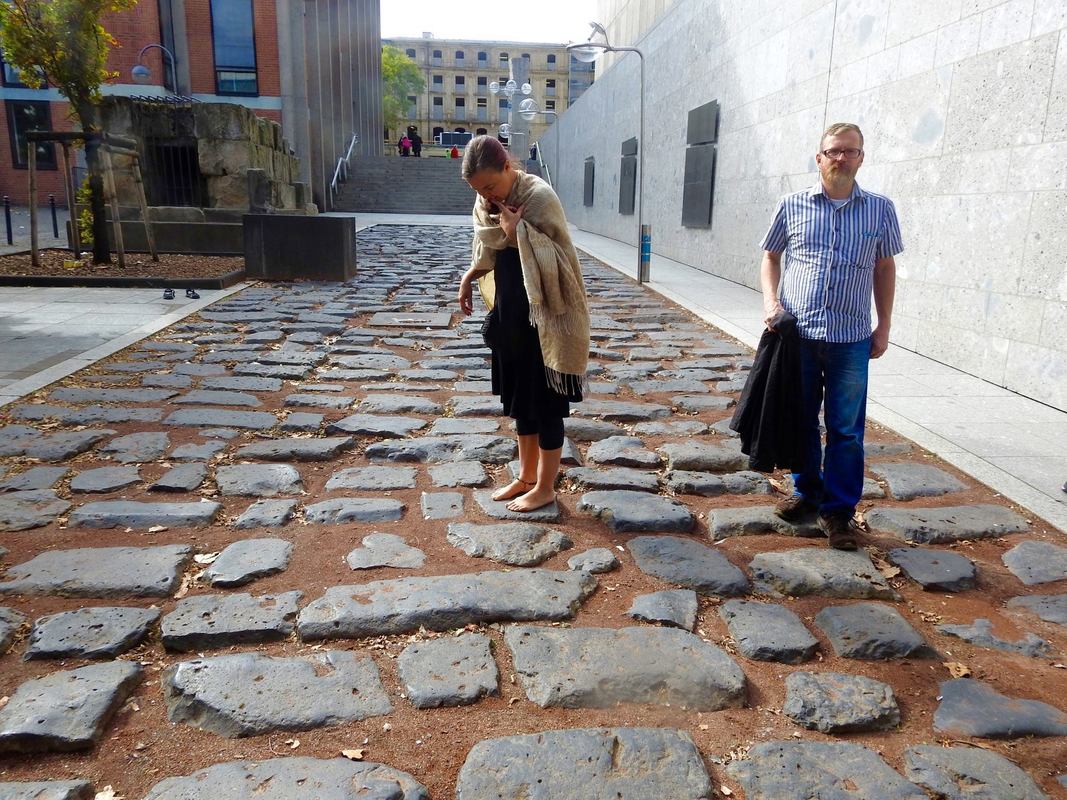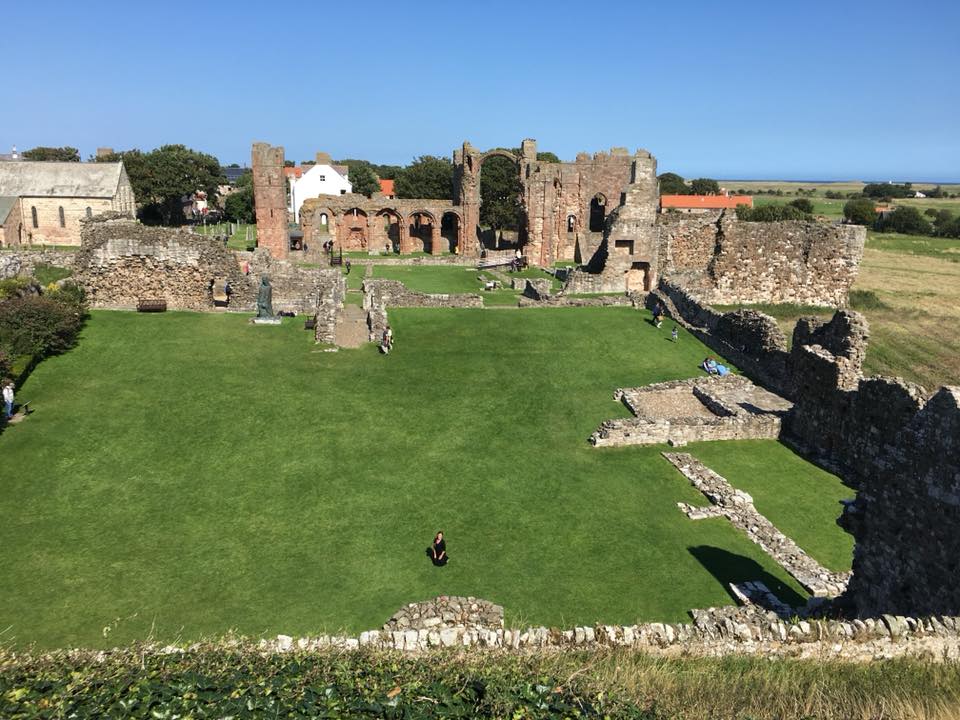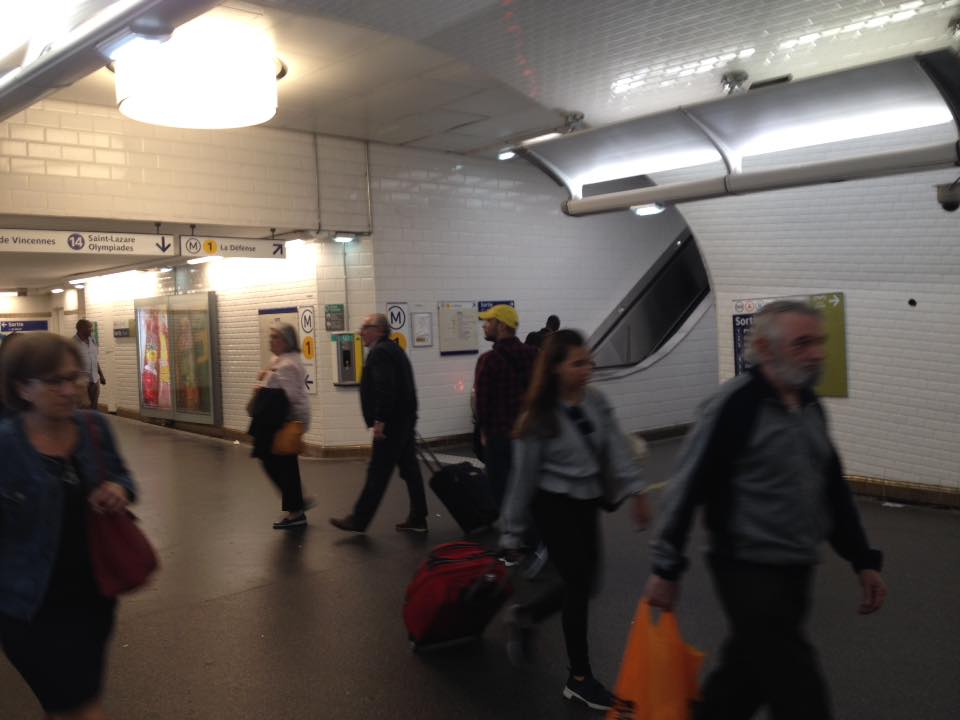- Home
- Explore
- Kids
-
St. Marks ABQ
- Beatitudes
- Catechesis
- Ministry Training
- Devotions
- Advent O Antiphons
- Advent Prayers
- Advent Stories
- Winter Saints
- Advent Creation Waits
- 40 Bible Stories
- Acts
- Summer Stories
- Parent Group
- SMMS Chapel News
- Chapel Time
- Song of the Month
- Contemplation and Chant
- Icon Visits
- Holy Week >
- Liturgy Class
- Reflections
- Blog
- draft
|
Pausing to pray in the midst of the monastery ruins on Lindisfarne (Holy Island), UK. The present day parish church can be seen just beyond the ruins, in upper left hand corner of the photo. Then Jesus asked them, ‘You see all these, do you not? Truly I tell you, not one stone will be left here upon another; all will be thrown down.’ (Matthew 24:2) We hear some variation of this statement from Jesus in all three synoptic gospels (Matthew, Mark and Luke.) Honestly. It's no wonder they killed him. Whenever we humans are working hard to build or maintain some monumental program or project or structure or institution or business or church or other modern day "temple", this is definitely NOT a message we want to hear. But, like it or not, what Jesus says is true. And, I believe, nestled in the (often hard) truth of Jesus' words there is always Good News. Jesus asked them, ‘You see all these, do you not? Truly I tell you, not one stone will be left here upon another; all will be thrown down.’ So where is the Good News in this future Jesus promises? My visit to Holy Island/Lindisfarne (a small island off the Northeast Coast of England) this past summer got me thinking about foundations. Just beyond the present day parish church on Lindisfarne are the ruins of the 12th century priory. The medieval priory was built on the site of a 7th century Anglo-Saxon monastery, which in turn was quite possibly established on the site of some pre-Christian worship or devotion. Here's the history of Holy Island in a nutshell: In 635 St. Aidan founded the first Christian monastery on Holy Island. A century and half later, in 793, Viking raids forced the monks on Holy Island to abandon the monastery and flee to the mainland. Some 400 years later, in the 12th century, monks from the mainland re-established a religious community on Lindisfarne and built a magnificent new church on the site of the former monastery church. A small monastic community continued on the site for another 400 years or so, until 1537, when, to mark the severing of ties between the Church of England and the Church of Rome, King Henry VIII ordered the dissolution of all English monasteries. Today a Christian community gathers to worship on Holy Island in a church building just steps from the old monastery ruins. But in due time that building-- and the institutions that support it --will undoubtedly crumble and fall, as well. The inevitable crumbling of the church as we know it--along with every other structure and monument we spend our lives laboring to erect and maintain--seems somehow less disastrous when seen from amidst the ruins on Holy Island. Sure, my present pet project might be destroyed or abandoned, but in 400 (or 4 or 4,000) years another generation might well come and build something beautiful for God on the foundation of what I so painstakingly sought to erect. Everything we build, we build on foundations left by those who came before us. And everything we build--even when it falls--can become part of the foundation on which those who come after us may build. When we come to trust that the only true foundation on which we build is none other than Jesus Christ, then we can persevere in working with due care and diligence, but without undue pride or anxiety. We can do our small part to build something that is beautiful, solid, and useful for a time, in the full and certain knowledge that our most useful, solid, beautiful constructions are also always temporary. All will be thrown down. Which is, it turns out, actually fine. It is, in fact, as it should be. In a few days the Church will enter the season of Advent. A season of darkness. Of waiting. Of anticipation. As we mark the beginning of the Circle of the Church Year, can we not only accept, but even rejoice in the dismantling of our old structures, old accomplishments, old monuments, old dreams? I tell you, not one stone will be left here upon another; all will be thrown down. Can we watch, unflinchingly, as our old temples fall? So that can we rejoice in doing our next small part, with God, in creating something new?  Walking barefoot in Cologne, Germany on the excavated remains of a Roman road built c. 50 AD,
1 Comment
Earlier this fall my husband and I met in Paris for a mini-vacation--our first experience of international travel together in our 15+ years of marriage. It was delightful and infuriating and hilarious to witness the radically divergent ways in which Donnel and I responded in the face of the challenges of the unknown.
Upon our arrival in an unfamiliar place, uncertain which direction to go, Donnel's approach was characterized by extraordinary patience and unhurried curiosity. Left to his own devices, he would study the map for 10 minutes. Then he would rotate the map 1/4 turn clockwise and study it for another 10 minutes from that vantage point. And so forth. Until shadows lengthened. And night fell. And we missed dinner. And we missed our plane. And we grew old together on the subway platform in a foreign land. My approach, on the other hand, was characterized by bold action and impatient curiosity. "I think we should go this direction," I would announce with an air of completely unfounded authority, and begin briskly and purposefully walking in some direction. I figured, "If we're going to be lost, I'd rather be lost seeing the city than lost looking at the map." Plus I think my mother must have impressed upon me at an early age (when I was a young girl studying ballet in the big city) that, in order to avoid being mugged or kidnapped, it was important to always carry yourself with confidence and look like you knew where you were going. For anyone who has known Donnel or me for more than 10 minutes, none of this will come as a surprise. What DID surprise (and humble) me was the chance to notice my own sense of panic and immediate resistance in the face of every new challenge and unfamiliar situation. I would descend into the subway station and immediately think "Oh my God! Oh no! I can't do this! I don't know where to go!" A saner version of me would say "Of course you don't know where to go. You've never been here before. You're not expected to know how to do something BEFORE you do it. You'll figure it out by doing it. That's how we learn. Besides which, that's what all the signs and maps posted all over the place are for. To help you figure out where you are and how to get where you want to go. " Like I have said, in my head if not out loud (and somewhat impatiently, I must admit) to anxious church members in the face of new or unknown challenges about a zillion times. In ministry contexts I've chosen and learned to embrace and cherish the necessity of venturing into unknown territory as an exhilarating opportunity to be surprised anew by God's astounding faithfulness and by unknown reserves of giftedness, resiliency, and creativity in myself and others. It took a trip down into the Paris subway system to remind me that I can be just as anxious and grouchy in the face of the unknown as the most anxious and grouchy parishioner. (There's almost a pun in there....Paris....Parish...) Luckily God loves all of us enough to accept us just as we are AND God loves all of us too much to enable us to remain that way. Later this month I'll travel to Costa Rica for a Spanish Immersion course, then we'll travel as a family to the Philippines to visit Donnel's family over Christmas. And I'll get to experience (and choose to resist or embrace) the anxiety of the unknown all over again. And so I'll get another chance. And so will the church. And so will you. |
AuthorMy name is Sylvia Miller-Mutia, and I am a priest in the Episcopal Church. I have recently accepted an exciting call to serve as assisting clergy at St. Mark's Episcopal Church in Albuquerque, NM with a focus on outreach, evangelism, and family ministry. I continue serving as "priest at large" for the larger church and wider world, assisting the people of God in whatever ways I can, and developing new resources for spiritual formation to share. Prior to my current call, I served as Rector (aka Pastor) of St. Thomas of Canterbury Episcopal Church in Albuquerque, NM (2015-2018), Assistant Rector at St. Gregory of Nyssa Episcopal Church in San Francisco, CA (2010-2015) and Pastoral Associate for Youth & Families at St. Stephen's Episcopal Church, Belvedere, CA (2002-2009). I am married to Donnel (grief counselor, couples coach, artist, best dad ever), and we have three awesome kids, ranging in age from 8-14. Archives
June 2023
Categories |



 RSS Feed
RSS Feed